AMD Zen 4 Ryzen 9 7950X and Ryzen 5 7600X Review: Retaking The High-End
by Ryan Smith & Gavin Bonshor on September 26, 2022 9:00 AM ESTCPU Benchmark Performance: Power, Web, And Science
Our previous set of ‘office’ benchmarks has often been a mix of science and synthetics, so this time we wanted to keep our office section purely on real-world performance. We've also incorporated our power and science testing into this section too.
In this version of our test suite, all the science-focused tests that aren’t ‘simulation’ work are now in our science section. Where possible these benchmarks have been optimized with the latest in vector instructions.
We are using DDR5 memory on the Ryzen 9 7950X and Ryzen 5 7600X, as well as Intel's 12th Gen (Alder Lake) processors at the following settings:
- DDR5-5200 CL44 - Ryzen 7000
- DDR5-4800 (B) CL40 - Intel 12th Gen
All other CPUs such as Ryzen 5000 and 3000 were tested at the relevant JEDEC settings as per the processor's individual memory support with DDR4.
Power
The nature of reporting processor power consumption has become, in part, a dystopian nightmare. Historically the peak power consumption of a processor, as purchased, is given by its Thermal Design Power (TDP, or PL1). For many markets, such as embedded processors, that value of TDP still signifies the peak power consumption. For the processors we test at AnandTech, either desktop, notebook, or enterprise, this is not always the case.
Modern high-performance processors implement a feature called Turbo. This allows, usually for a limited time, a processor to go beyond its rated frequency. Exactly how far the processor goes depends on a few factors, such as the Turbo Power Limit (PL2), whether the peak frequency is hard coded, the thermals, and the power delivery. Turbo can sometimes be very aggressive, allowing power values 2.5x above the rated TDP.
AMD and Intel have different definitions for TDP but are broadly speaking, applied the same. The difference comes from turbo modes, turbo limits, turbo budgets, and how the processors manage that power balance. These topics are 10000-12000 word articles in their own right, and we’ve got a few articles worth reading on the topic.
- Why Intel Processors Draw More Power Than Expected: TDP and Turbo Explained
- Talking TDP, Turbo and Overclocking: An Interview with Intel Fellow Guy Therien
- Reaching for Turbo: Aligning Perception with AMD’s Frequency Metrics
- Intel’s TDP Shenanigans Hurts Everyone
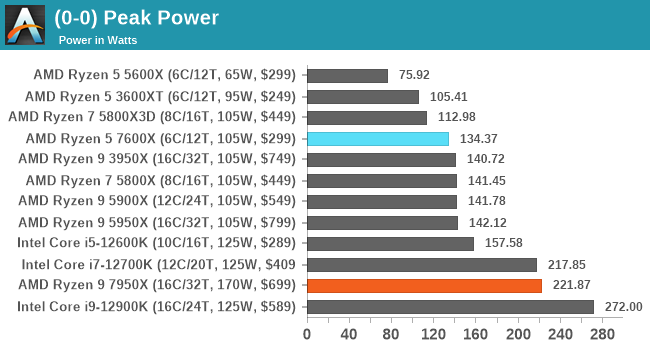
Looking at the results of our Peak Power test, the Ryzen 9 7950X topped out at 221.8 W, which is around 30% higher than the TDP of 170 W it comes with. As stated by AMD, the Power Package Tracking or PPT limit for AM5 motherboards when used with 170W TDP Ryzen 7000 SKUs will be 230 W. Still, while it draws more power than its generational predecessors such as Zen 3 and Zen 2, the Zen 4-based Ryzen 7000 series benefits from higher core clock speeds, a higher single core boost frequency, as well as other implementations around TSMC's 5 nm manufacturing process.
The AMD Ryzen 5 7600X is more aimed at the mid-range, and as such has a lower overall power draw, with the peak power figures in our testing reaching 134.3 W. This is around the same levels of power draw as the Ryzen 9 3950 X, the Ryzen 9 5900X, and the Ryzen 7 5800X. Per AMD's specifications, the Ryzen 5 7600X has a TDP of 105 W, with around a 27 % variance in peak power compared to TDP.
From our testing, so far, it seems that Ryzen 7000 when combined with a premium X670E motherboard allows for up to 30% in terms of extra power allowances for higher single-core boost and overall faster all-core frequencies.
Web
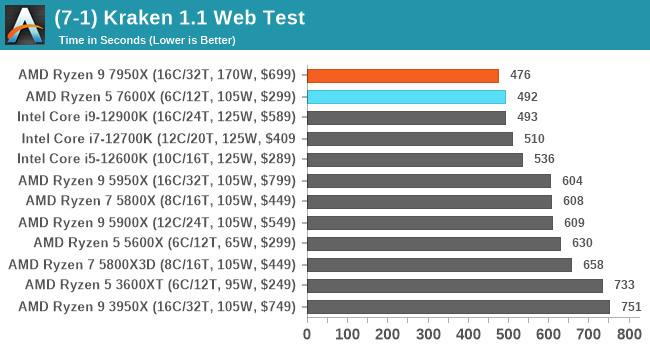
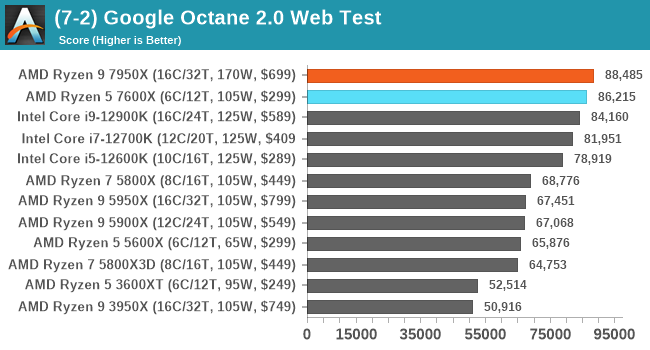
In our web tests, the overall improvements in IPC, frequency, clock speeds, and the switch to DDR5 all play a part in performance here. Both the Ryzen 9 7950X and Ryzen 7 7600X top our charts in regards to web testing, although performance isn't as apparent as it should be in other areas.
Science
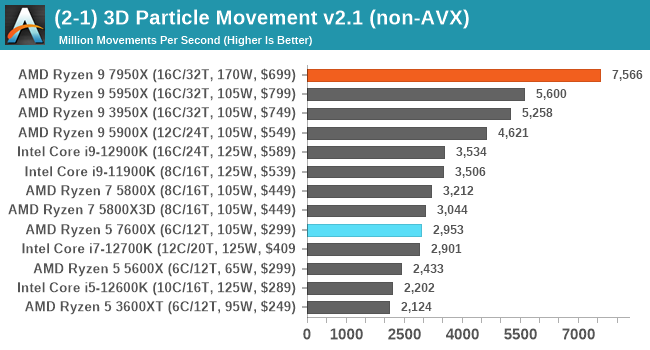
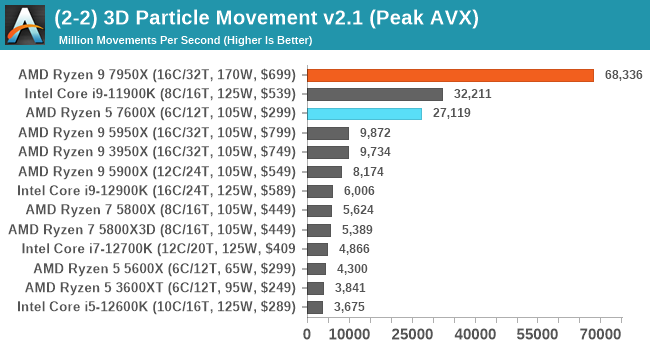
For our 3DPM v2.1 testing, we added in the Intel Core i9-11900K (Rocket Lake) to show performance across AVX workloads. Although Intel officially fused off the AVX2/512 extensions on Alder Lake which did cause a little controversy and gave the impression that AVX-512 on consumer platforms was dead. AMD clearly believes the opposite, as it has implemented it so that AVX-512 runs two cycles over a 256-bit wide instruction. The performance of the Ryzen 9 7950X here is phenomenal, although the Core i9-11900K which did indeed feature AVX instruction sets in the silicon, is still better than the Ryzen 5 7600X with AVX workloads.
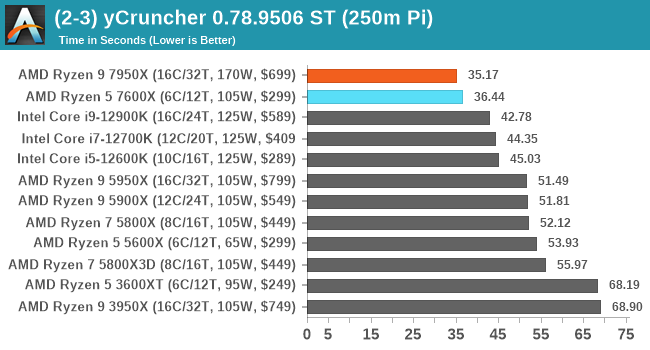
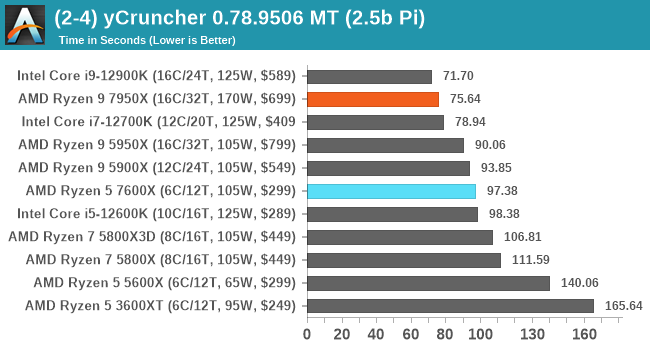
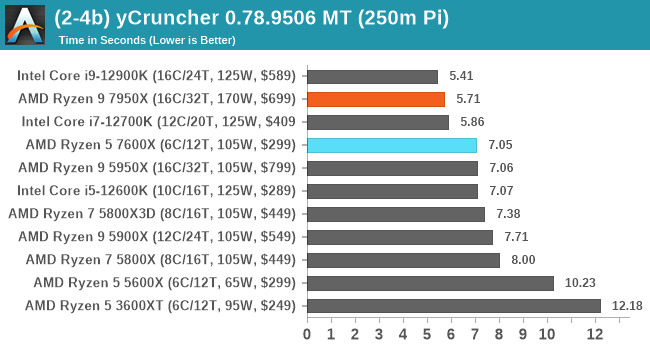
Focusing on our more science-based tests, both the Ryzen 9 7950X and Ryzen 5 7600X perform well against the competition. In our 3DPMv2.1 test in non-AVX, the Ryzen 9 7950X provided a jump of 35% in performance against the previous generation Ryzen 9 5950X processor.
Interestingly, in our yCruncher 0.78 test, the Ryzen 9 7950X and the Core i9-12900K trade blows consistently, although the Ryzen 5 7600X performs well for its price point.










205 Comments
View All Comments
RestChem - Wednesday, October 5, 2022 - link
Meh, time will out the ultimate price-points and all that, but as it emerges I really wonder what kind of users are looking to drop this kind of dollarses on high-end AMD builds. My gut is that they've priced themselves out of their primary demographic, and max TDP is right up there too, same as with their GPUs. When it comes down to a difference of a couple hundred bucks per build (assuming people build these with the pricey DDR5-6000 there's scant mobo support for through whatever AMD's integrated mem-OC profile scheme is) are there going to be enough users who just root hard enough for the underdog to build on these platforms, contra even high-end Alder Lake or (however much extra, reamins at time of writing to be seen) Raptor Lake builds? Before the announcements I was expecting AMD to get in cheap again, promise at least like performance for a bit of a discount, but it seems even those days are over and they want to play head-to-head. I wish them the best but I don't see them scoring well in that fight. Replytvdang7 - Thursday, October 6, 2022 - link
" I have a 1440p 144Hz monitor and I play at 1080p just because that's what I'm used to."Is this some kind of joke. We are supposed to listen to reviewers that are stuck in 2010 Reply
Hresna - Sunday, October 9, 2022 - link
I’m curious as to whether there’s any appreciable difference to a consumer as to whether a particular PCIe lane or USB port is provisioned by the CPU or the Chipset…. Like, is there a reliability, performance, or some other metric difference?I’m just curious why it’s a design consideration to even include them in the CPU design to begin with, unless it has to do with how the CPU lanes are multiplexed in/out of the CPU and somehow some of the lanes can talk inter-device via the chipset without involving the cpu… Reply
bigtree - Monday, October 10, 2022 - link
Where is octa channel memory? dual channel memory is a $300 CPU.Where is native Thunderbolt 4 support?
(mac minis have had thunderbolt 3 for over 5 years).
Cant even find one X670 Motherboard with 4x Thunderbolt 4 ports. And you want $300? Thunderbolt 4 should be standard on the cheapest boards. Its a $20 chip. Reply
Oxford Guy - Monday, October 10, 2022 - link
The mission of corporations is to extract profit for shareholders and protect the lavish lifestyles of the rich. It is not to provide value to the plebs. Do the absolute minimum is the mantra. ReplyRedGreenBlue - Tuesday, October 11, 2022 - link
That must be why Intel made Thunderbolt royalty-free and it’s now built into USB 4. ReplyOxford Guy - Wednesday, October 12, 2022 - link
It probably can afford to since states like Ohio are willing to bankroll half of the cost of its fabs. ReplyRedGreenBlue - Tuesday, October 11, 2022 - link
It’s built into USB 4 now. Just make sure it’s functional already because it might need a driver, AMD did that on the 600 series. Aside from that important fact, I don’t care if there aren't many boards with it. The thunderbolt ecosystem has been crap since the beginning. Peripheral makers didn’t take advantage of it because USB was a more common approach and intel didn’t make thunderbolt cheap to implement. The Mac Minis have it because Apple made a big bet on it when it came out. These days it’s nice to have but it’s a throw-away feature unless you have a niche product that needs it. It’s for niche purposes and that would have been a waste of pci lanes. I would’ve liked it for external GPU’s but intel effectively shut that down and I don’t know if they’ve opened the door to it again. USB is way more convenient. ReplyRedGreenBlue - Tuesday, October 11, 2022 - link
And 8 channel memory, like, this sounds like a joke. That’s for server or workstation cpus because of how many layers it takes for the wiring on the board and the pins on the socket. That’s part of why server and workstation boards are so expensive. If you need that much bandwidth you’re in the wrong market segment. Look at Threadripper chips. ReplyRedGreenBlue - Tuesday, October 11, 2022 - link
It would be appreciated if architecture reviews had the pipeline differences in a chart to compare across generations. Anandtech used to have that included and it gave a good comparison of different generations and competitor architectures. I can understand not including it in the product review but I don’t remember a chart being in the previous Zen 4 overview article. Reply